Here is a comprehensive review of the Fisher F75 metal detector, highlighting its key features and performance. Whether you’re an experienced detectorist or a beginner, this review will guide you through the F75’s operating frequency, search coil, accessories, battery life, and more. We’ll explore how these features contribute to the detector’s efficiency in the field, helping you decide if it’s the right tool for your treasure-hunting adventures.
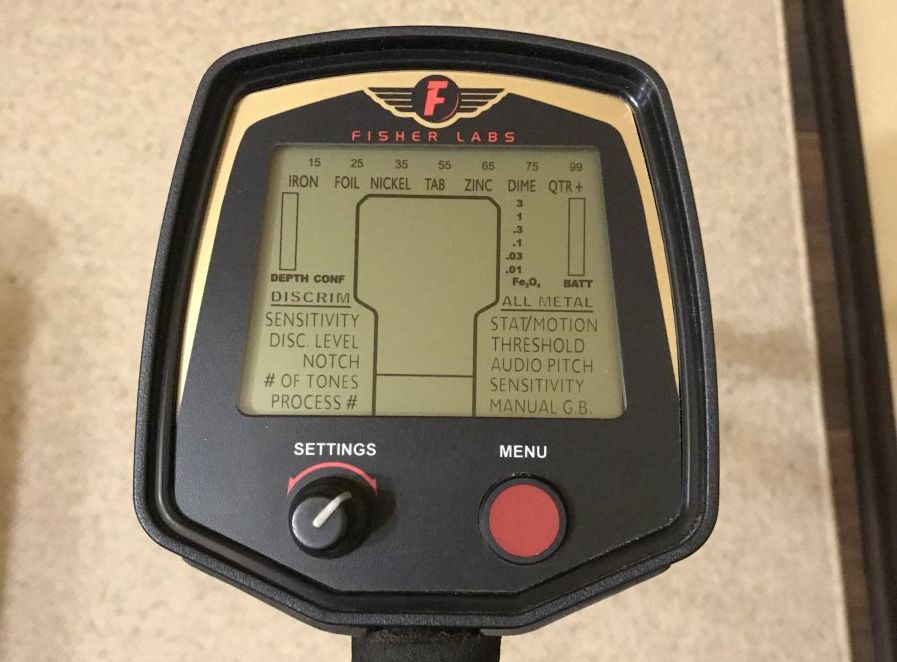
Contents
What was the device designed for?
Fisher F75 metal detector is a device of professional level. It was designed by a famous manufacturer First Texas Instruments. Its facilities are located in the USA, so American quality is one of many advantages of the metal detector.
The Fisher F75 operates at a frequency that balances depth and sensitivity, making it effective for locating a wide variety of targets, from small relics to deeper objects. Equipped with a highly responsive search coil, the detector ensures accuracy even in challenging environments like mineralized soil. While headphones are not always included in the standard package, many users find them essential for filtering out background noise, especially in noisy or windy conditions.
One of the standout features of the Fisher F75 is its impressive battery life, allowing the device to run for long periods on a single set of batteries. This makes it ideal for extended hunts without frequent battery replacements. Additionally, the lightweight design ensures comfort during long detecting sessions, reducing arm fatigue.
Other notable features include multiple search modes, which allow users to customize settings based on specific ground conditions and target preferences. Whether you’re detecting in a park, beach, or field, the Fisher F75 adapts to different terrains with ease, offering versatility for hobbyists and professionals alike.
| Model | Fisher F75 |
| Weight | 3.5 pounds (1.6 kg) |
| Batteries | 4 AA, alkaline (not included) |
| Headphones | Not included |
| Warranty | 5 years |
| Operating Principle | VLF |
| Standard Searchcoil | 11” (28 cm) DD |
| Operating Frequencies (kHz) | 13 kHz |
| Water resistance | Waterproof coil |
| Submersion Depth | No |
| Updatable Software | No |
| Discrimination | Yes |
| Ground Balance | Auto, manual |
| Audio Threshold | Yes |
| Electronic Pinpointing | Yes |
| VDI (0 to 99 scale) | Yes |
| Build-in flashlight | Yes |
- Lightest weight / best ergonomics in the industry – powerful performance…
- Double-filter discrimination modes for searching in trashy areas – magnetic…
- Non-volatile memory saves settings – backlight – for low light hunting…
- Double-D Waterproof Search Coil – Rain Cover for Control Housing & Battery…
- Recommended for: coin shooting, relic hunting, beach hunting, gold prospecting….
- Features Boost Process substantially increases depth under most conditions…
- Three new levels of FeTone: Iron Audio Off, Low or Medium (complements existing…
- Lightest and best balanced of all high-performance metal detectors; Best…
- Trigger-Actuated FASTGRAB Ground Balance Manual Ground Cancellation Option…
- Backlight – For Low Light Hunting Conditions Low Operating Cost – Typically…
Last update on 2025-07-10 / Affiliate links / Images from Amazon Product Advertising API / Source: Amazon Affiliates
The Fisher F75 metal detector is available in two versions: the Standard Package and the Special Edition. The Standard Package is easy to recognize with its gold shaft, while the Special Edition features a sleek black shaft and offers enhanced performance.
So, what sets the Special Edition apart? According to the manufacturer, the Special Edition provides a 15-20% increase in detection depth compared to the standard model, thanks to its more powerful processor and improved waterproofing capabilities. These upgrades allow for more efficient treasure hunting, particularly in challenging environments where greater depth and processing power are essential.
Additionally, the Fisher F75 Special Edition comes equipped with two new advanced search modes:
- Boost Process: Enhances detection depth and sensitivity, making it ideal for locating deeply buried or faint signals.
- Cache Locating Process: Specifically designed to help users find larger, deeply buried objects like caches or hoards.
The Special Edition package also includes a smaller, 5-inch search coil, which is perfect for detecting in tight spaces or areas with heavy trash. Occasionally, the package may include protective cases and a pinpointer, adding further value to this version.
Given these enhanced features and additional accessories, it’s no surprise that the Special Edition comes with a higher price tag compared to the Standard Package.
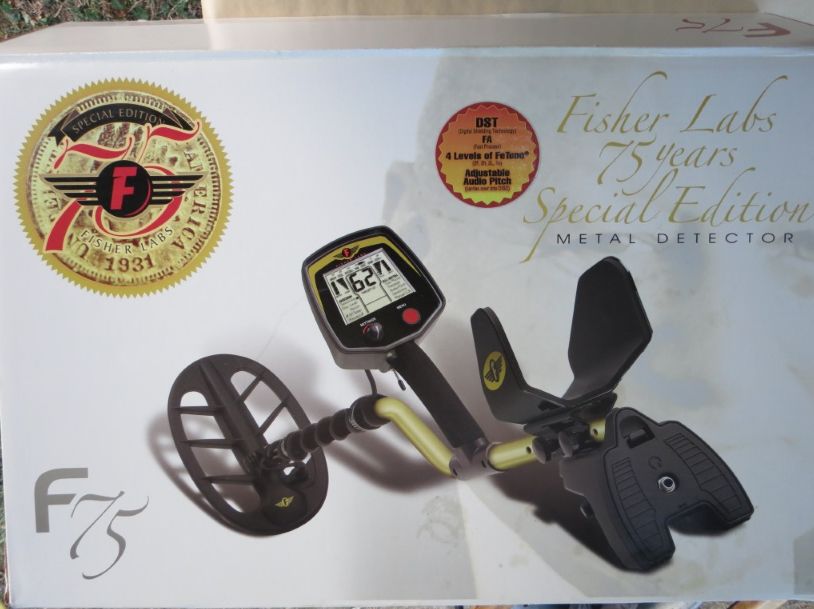
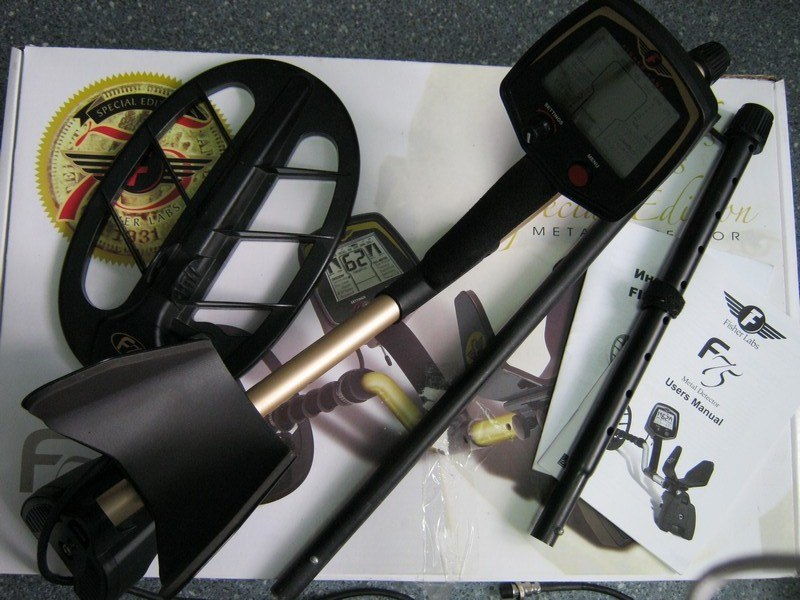
The review
Shaft
The Fisher F75 metal detector features a uniquely designed shaft that sets it apart from earlier models like the Fisher F22 and F44. Unlike previous designs, the F75’s shaft offers enhanced balance and durability, thanks to a shift in the placement of key components. The battery holder and headphone jack have been moved to the armrest, making the device more comfortable to use for extended periods. This adjustment also improves the overall balance of the metal detector, reducing strain during long treasure-hunting sessions.
The flagship model’s shaft design is S-shaped and built with three interlocking sections. The middle and upper sections are made from an aluminum alloy, coated with a wear-resistant powder paint, ensuring longevity even in harsh conditions. Meanwhile, the lower shaft section is crafted from carbon fiber, a lightweight and non-magnetic material that adds durability without affecting detection accuracy. This combination of materials results in a robust, reliable shaft that can withstand frequent use in tough environments.
Connecting the three shaft sections is simple and secure. They are fastened with spring buttons and reinforced with swivel-type clips and collet clamps, resulting in a sturdy and stable construction.
The adjustable armrest on the F75 is another standout feature. Unlike the plastic armrests found on previous models, this one is made of aluminum, providing greater durability. The armrest can be adjusted to accommodate various clothing layers, so whether you’re out in the summer heat or bundled up for winter treasure hunting, you can customize the fit for comfort. Additionally, the armrest is designed to prevent cracking or breaking from accidental impacts.
Another innovative feature is the rest located underneath the armrest, which allows users to lean the detector on the ground without it tipping over or getting dirty. This feature is especially useful when digging for targets, as it keeps the device clean and upright.
Lastly, the armrest also houses the battery holder, volume control, external speaker, and headphone jack, making these components easily accessible.
Despite being loaded with advanced features, the Fisher F75 remains impressively lightweight for a professional-grade detector, weighing just 3.5 pounds (1.6 kg) including the batteries. Compared to other models in its class, the F75’s light weight enhances ease of use without compromising performance, making it ideal for extended treasure-hunting excursions.
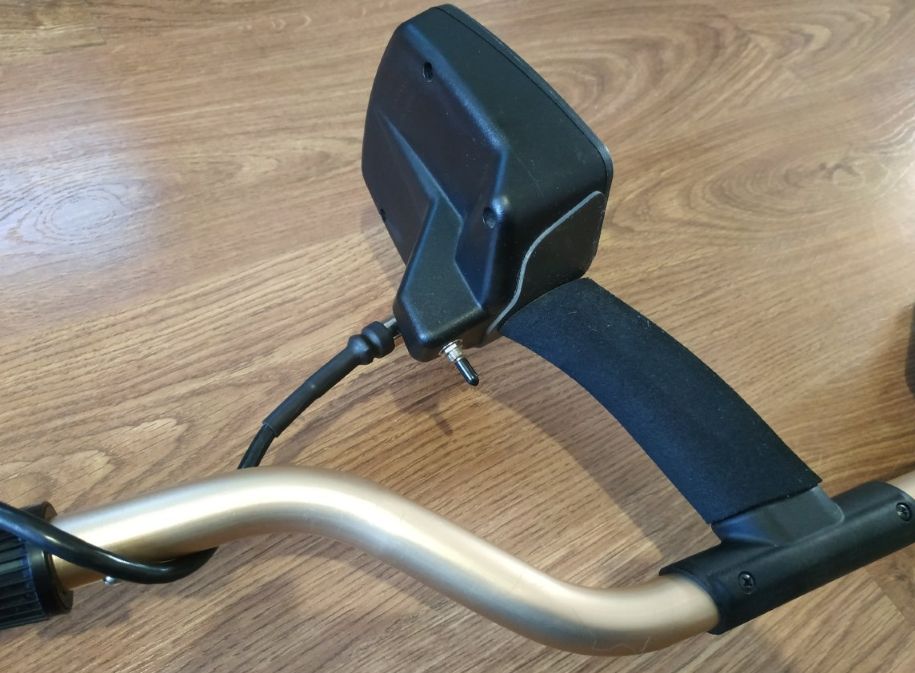
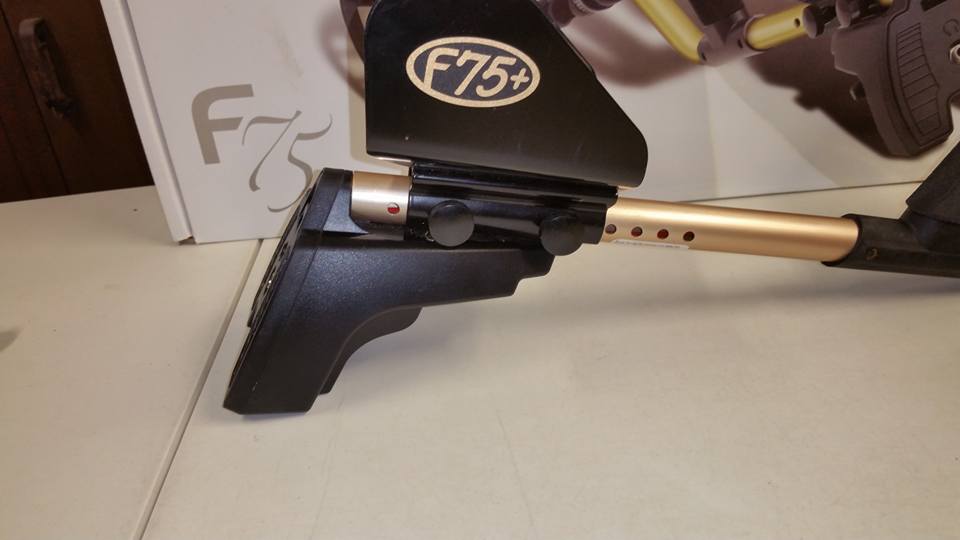
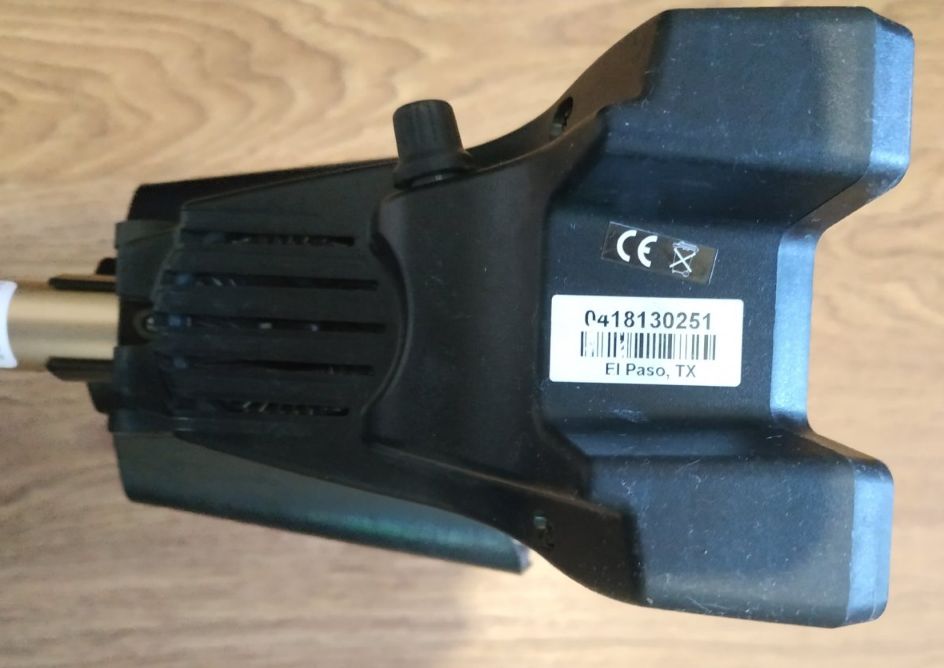
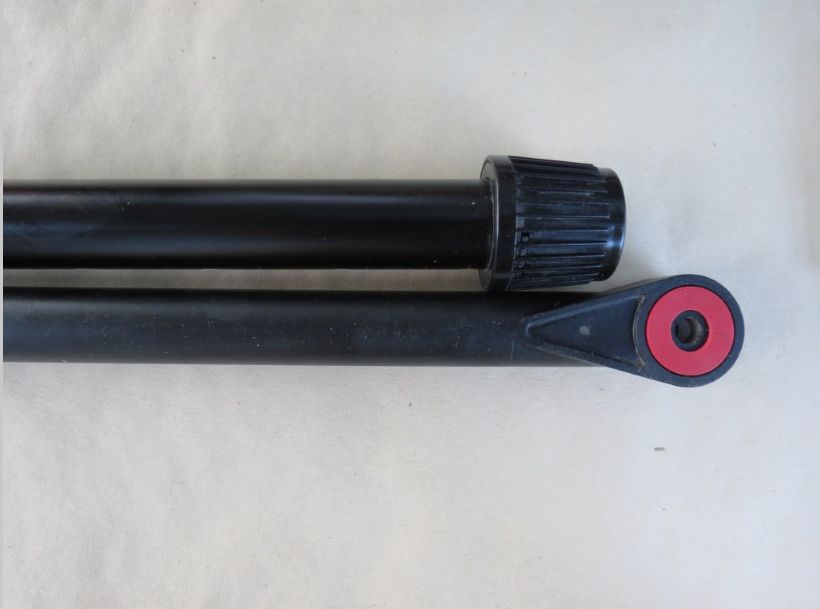
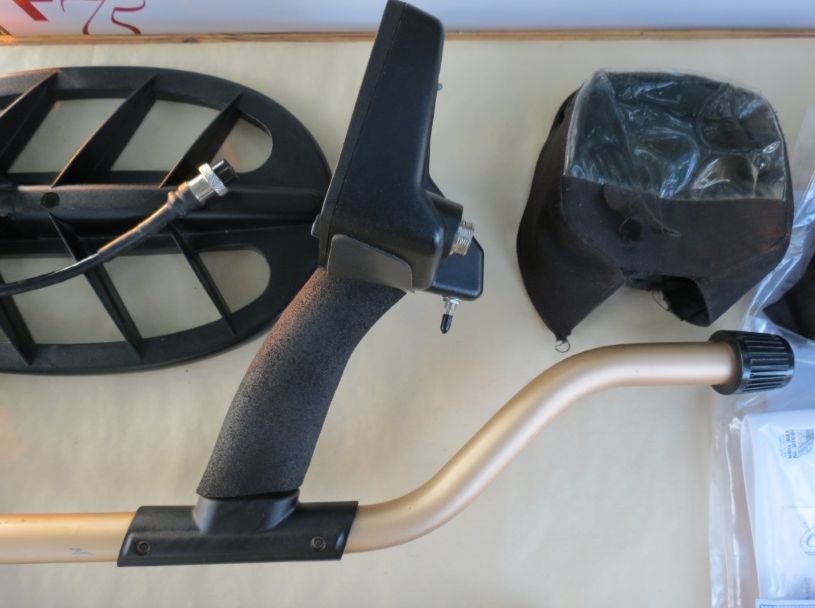
The coil
The Fisher F75 metal detector comes equipped with an 11-inch elliptical DD search coil, designed to offer outstanding performance in a variety of treasure-hunting conditions. Known for its significant detection depth and high level of discrimination, this coil excels at identifying both small non-ferrous targets, like gold and silver jewelry, as well as larger items.
One of the key features of this coil is its versatility. Whether you’re coin shooting or searching for larger artifacts, the Fisher F75 delivers precise target identification, especially for smaller objects. The device’s ability to pinpoint the center of small targets, such as coins or copper relics, makes it highly effective in fields, parks, or other areas rich in buried items.
Operating at a 13 kHz frequency, the F75’s search coil is finely tuned for heightened sensitivity to small metal objects. While higher frequencies tend to attenuate quickly in the ground, this also makes the metal detector more responsive to detecting small, valuable items like golden rings or silver coins, even in challenging soil conditions.
The search coil is encased in a protective housing made from durable, wear-resistant plastic. This robust construction ensures the coil maintains its structural integrity over time, even with heavy use in rugged environments. Its monolithic design, reinforced bottom, and sturdy clamps provide extra durability, so you can rely on it during long treasure hunts.
The coil’s jack plug is designed with a threaded nut to ensure a secure and reliable connection to the detector, preventing accidental disconnections during use. This feature, combined with the coil’s durable case, makes the Fisher F75 a trusted tool for both beginner and experienced metal detectorists.
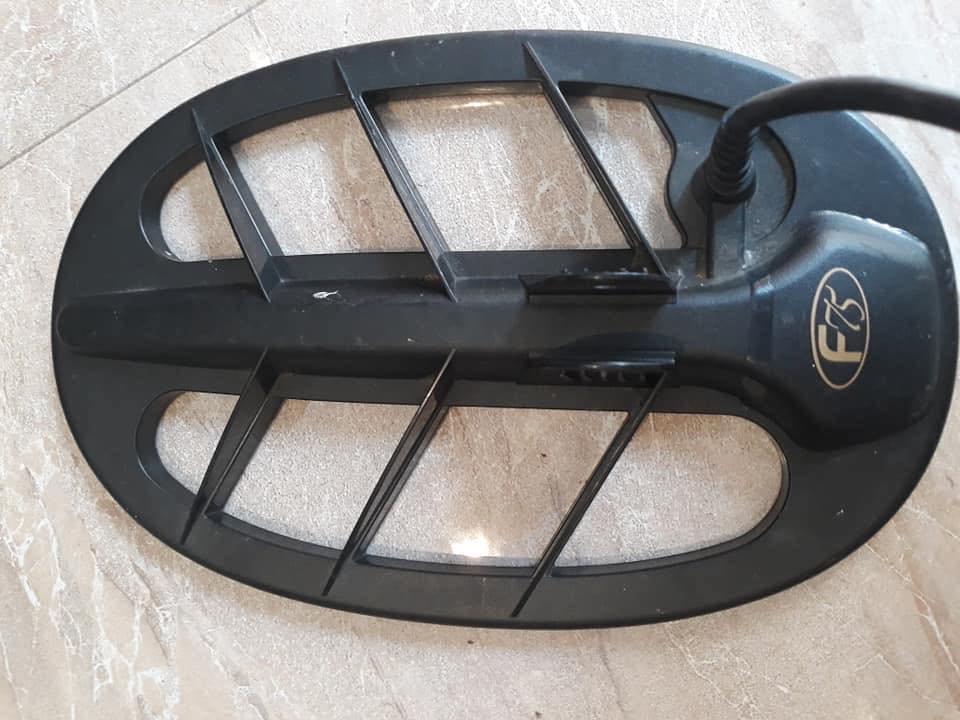
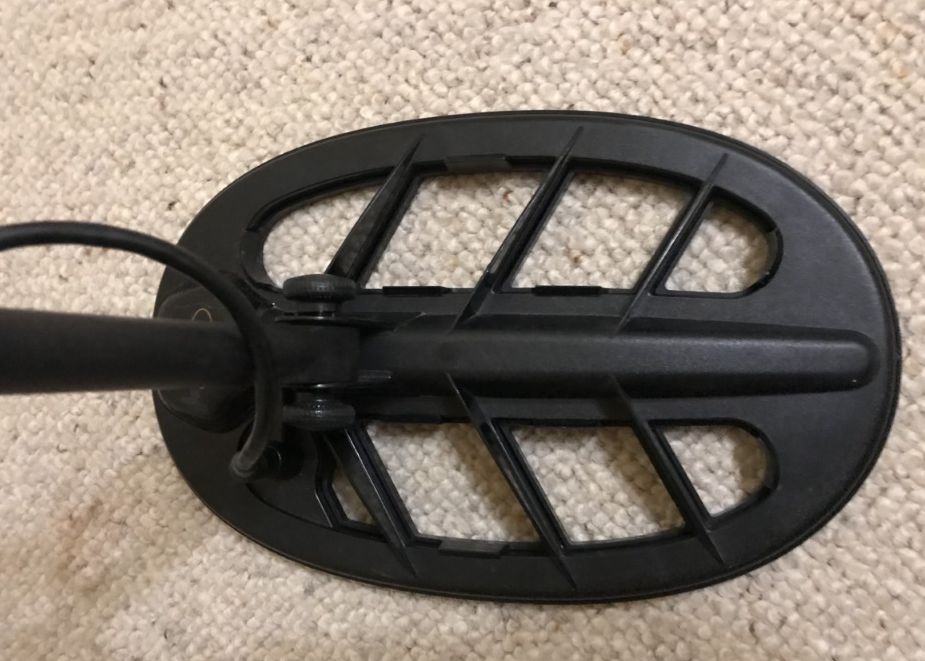
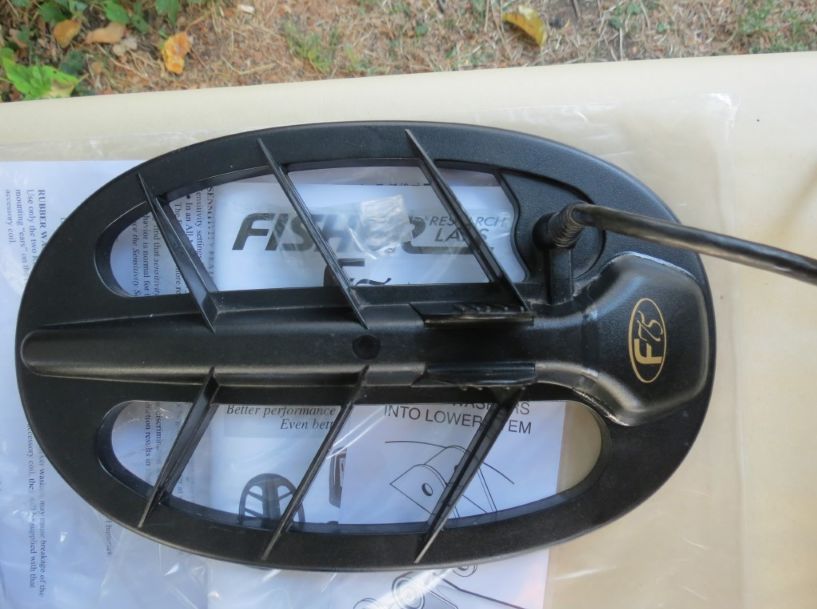
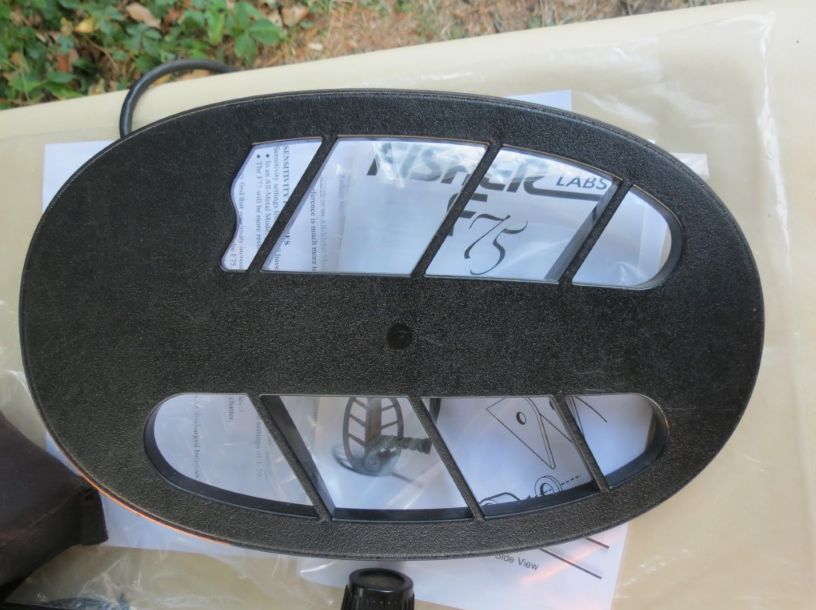
Headphones
Headphones are typically not included with the Fisher F75 metal detector, but the device is equipped with a headphone jack for users who prefer using them. Using headphones can greatly enhance your treasure hunting experience, especially in noisy environments or when detecting faint signals from small targets. Additionally, using headphones can extend battery life since the external speaker consumes more power. They also improve audio clarity, making it easier to distinguish between different types of signals, particularly in areas with high background noise, such as beaches or parks.
The device’s volume control is operated using a continuously adjustable analog potentiometer, which replaces the older numeric scale system. This potentiometer is conveniently located on the battery holder unit. By turning the potentiometer, you can both power on the metal detector and adjust the volume to your preferred level. The analog potentiometer offers finer control over the audio volume, allowing users to set the perfect level based on their environment.
This streamlined design simplifies the control unit, reducing the number of functions on the main interface. As a result, users can focus more on the search without being overwhelmed by complex controls, making the Fisher F75 easier to operate, even for beginners.
The battery
The Fisher F75 metal detector uses four AA batteries as its power supply, providing approximately 30 hours of continuous operation. This impressive battery life allows for extended treasure hunting sessions without the need for frequent replacements, making it a reliable choice for both casual and serious detectorists. The efficiency of the battery usage enhances the overall user experience, allowing you to focus more on searching for treasures and less on maintaining power supply.
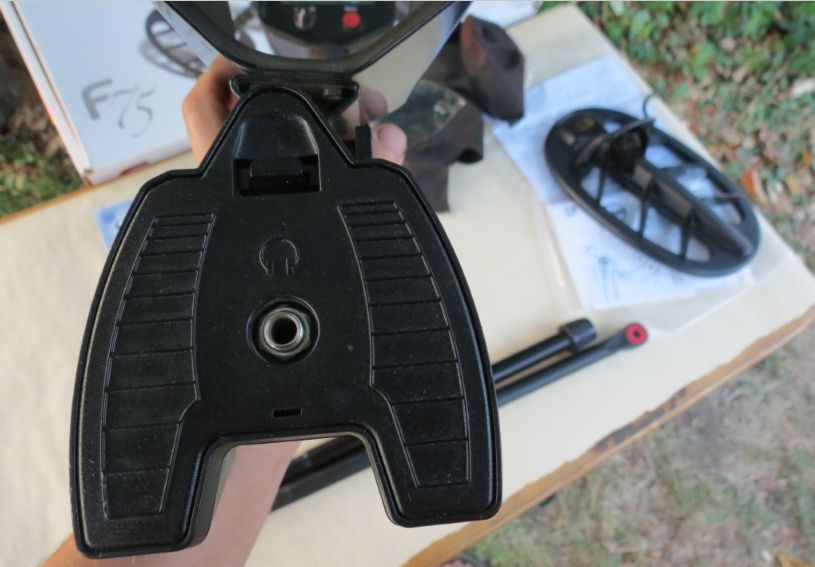
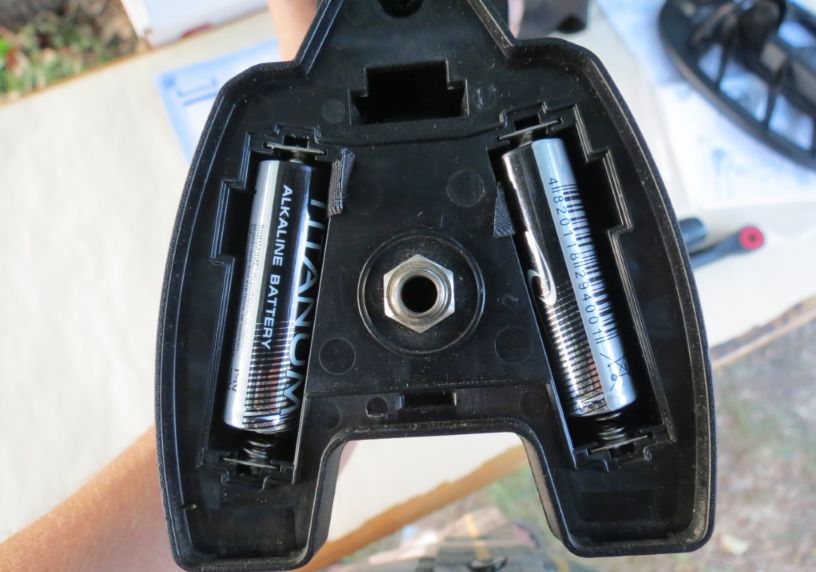
The control unit
The Fisher F75 metal detector features an intuitive control system that combines both a rotary switch and a button. This innovative design simplifies operation, making it easier to turn the switch than to press small touch buttons. This is especially beneficial in the field when precision is crucial.
In addition to the rotary switch, there is a three-position trigger located under the control unit, which can be easily operated with your pointer finger. When the trigger is in the ‘towards the user’ position, the pinpointer mode activates, allowing for precise target location. Conversely, when flipped to the opposite position, the FastGrab ground balancing mode engages, enhancing the detector’s sensitivity to different ground conditions.
The metals scale consists of eight segments, allowing users to conveniently exclude specific groups of metals, such as iron. In the bottom left corner of the display, users can see the device settings in discrimination mode. The top right corner indicates target detection depth and the level of ground mineralization. Additionally, the bottom right corner displays settings such as sensitivity and tone adjustments, while the top right shows battery charge and ferric oxide content indicators.
An essential convenience feature of the Fisher F75 is its ability to save the latest user settings when powering on and off. The LCD also includes a backlight, ensuring visibility even in low-light conditions, making it a reliable tool for treasure hunting at any time of day.
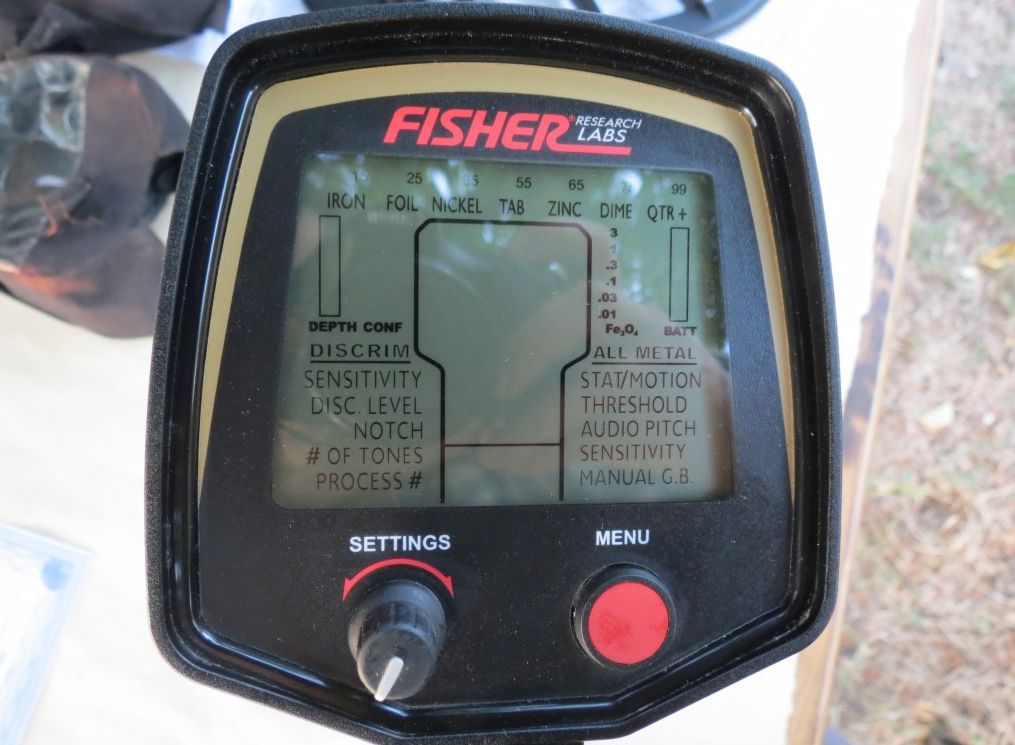
Search modes
The Fisher F75 metal detector employs a VLF (Very Low Frequency) approach, featuring two basic search modes: the All Metal mode, which operates without discrimination, and the discrimination mode. Additional search modes are available as professional settings that users can adjust according to specific conditions.
Standard Search Modes
- FA (Fast Process)
This mode is ideal for trashy areas, providing maximum fast target response and enhancing target identification through audio feedback. - dE (Default Process)
A multi-purpose search mode with medium response and recovery time, the dE mode offers maximal detection depth and sensitivity for a single coil wave, making it versatile for various hunting scenarios. - JE (Jewelry Process)
Not recommended for trashy areas, this mode detects all targets except ferrous metals. Jewelry hunting in this mode requires slower movements to ensure effective target identification. - BC (Bottle Cap Mode)
Designed specifically for areas littered with bottle caps, this mode detects unstable or repeated signals generated by caps. While it offers less effective discrimination than dE, it’s useful for minimizing unwanted signals. - PF (Plowed Fields)
The user manual provides vague descriptions of this mode, but it is designed to optimize performance in plowed fields.
Additional Modes in Fisher F75 Ltd SE
- BP (Boost Process)
Similar to dE, this mode amplifies detection depth parameters. It is particularly useful when the search coil cannot be positioned close to the ground, aiming to neutralize unwanted air-space signals. However, BP can be challenging, as it may produce phantom signals due to increased sensitivity. Slow movement of the search coil can help identify these signals, making it effective for detecting ferrous targets without discrimination. - CL (Cache Locating Process)
This mode can be used in conjunction with the All Metal mode, providing maximal detection depth with minimal recovery and response time. It is best suited for slow sweeping of the search coil while searching for deep, large targets.
Target Signal Tones
The Fisher F75 utilizes four tone sound signals to identify detected targets. While some users find this metal detector noisier than others, the shrill and squeaky sound can be challenging to adjust to. However, this is indicative of the device’s high sensitivity, which enables it to detect both small-sized targets and larger coins without confusion. The clarity of the signals is impressive, ensuring that users will not miss or misidentify valuable targets.
The FeTone feature allows users to decrease the volume level for specific VDI (Visual Display Indicator) ranges, improving target discrimination by ear and reducing fatigue during long sessions. This adjustment can make signals from ferrous targets less intrusive, providing relief to users at higher volume levels.
It’s important to note that while the JE mode generates more sounds, particularly due to its heightened sensitivity, the detection depth and response of the Fisher F75 are exceptional, making it a worthwhile investment for serious treasure hunters.
Discrimination
The Fisher F75 showcases impressive precision in detecting corroded iron targets. Users may occasionally encounter unclear signals; however, the detector generally provides a high degree of confidence that these signals indicate ferrous targets. Many of these signals often originate from flat, round shatters, which can pose detection challenges for many other devices.
As a result, the F75 demonstrates a high accuracy rate when identifying corroded iron, making it an excellent choice for treasure hunters who want to ensure they don’t miss potential finds.
Threshold
The threshold mode is designed for detecting deep targets. When this mode is activated, the metal detector transforms into a powerful pinpointer, eliminating the need for waving. Instead, users should slowly move the search coil to localize deep targets effectively.
For both static and dynamic modes, it is recommended to set the threshold level so that background noise is minimal and does not become bothersome. The key is to ensure the user can hear when the tone breaks, which is sufficient for accurate target identification.
Ground balance
The ground balance function in the Fisher F75 metal detector is primarily automatic (FastGrab), utilizing the standard method of waving the search coil over the ground.
However, there’s more to it. Users have the option to enable or disable Digital Shielding Technology (DST). Additionally, manual adjustment of ground balance is possible.
A ground mineralization indicator on the LCD display provides real-time feedback on the level of ground mineralization. This information is displayed as a convenient bar diagram, making it easy for users to assess the conditions.
Advantages:
- Excellent discrimination function
- Significant detection depth
- Numerous useful settings
- Effective for detecting small-sized targets
Disadvantages:
- Produces many odd sounds, making it quite noisy
- The primary process of settings adjustment can be complicated for beginners
Due to the high operating frequency of the search coil, users may hear many ‘odd’ sounds, making it challenging to identify the specific one needed. However, after using the device for a few weeks, users typically become accustomed to these sounds.
Additionally, the metal detector is sensitive to electrical noise. While it generally does not conflict with other devices, it cannot be used effectively in areas with nearby power transmission lines.
As for the device rivals, we can name Minelab Equinox 600, Garrett AT Pro and Teknetics Omega 8500.

